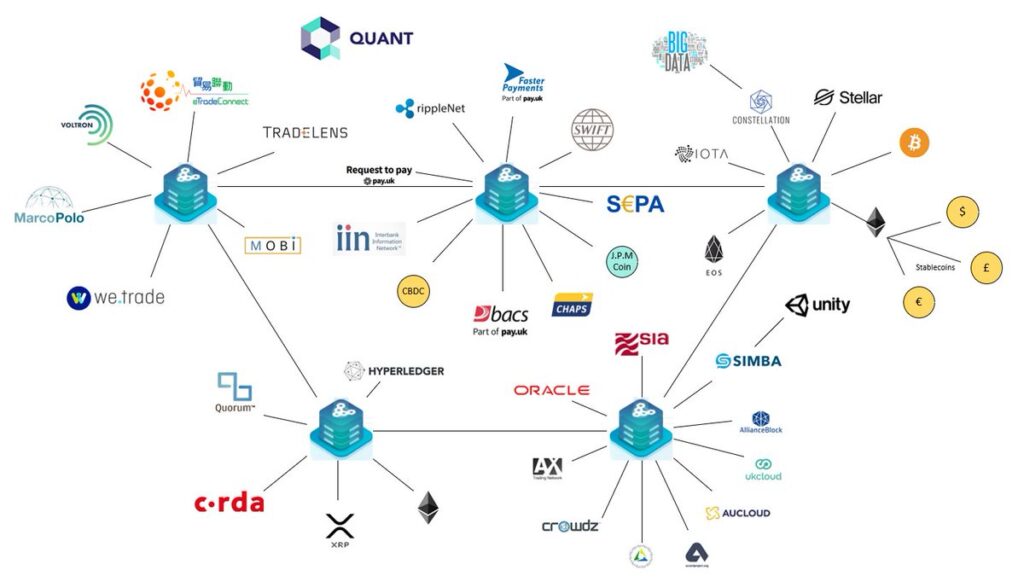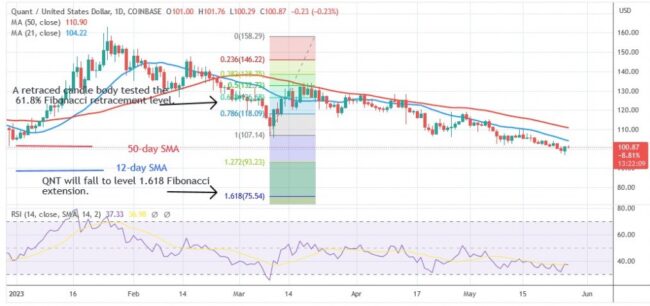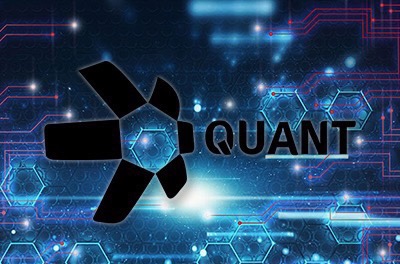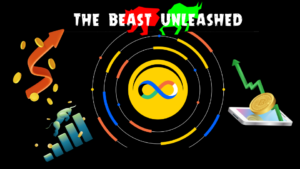Quant is a pioneer in the blockchain industry that leverages interoperability to transform digital ecosystems and generate economic growth. Gilbert Verdian, a seasoned technologist with a creative approach to blockchain technology, founded Quant, which uses its unique Overledger Network protocol to streamline and hasten the adoption and deployment of decentralized ledger technology (DLT). Quants have the potential to transform the blockchain landscape, promote cross-border cooperation, and nurture a more inclusive digital economy by connecting multiple blockchain networks.
This article examines Quant’s blockchain applications, their economic impact, strategic partnerships, future plans, and the visionary leadership of Gilbert Verdian. It also describes the fundamental characteristics of the Overledger Network protocol and how it promises to revolutionize blockchain operations in the digital world.
Table of Contents
Quant Blockchain Economic Development
The primary product of Quant, Overledger, is a revolutionary blockchain operating system (OS) that enables interoperability across multiple blockchain networks. This technological marvel connects the current private blockchain ecosystems to a multi-chain system, thereby creating an independent blockchain economy.
Network participants, such as developers, businesses, and end-users, are the primary contributors to the quant economy. The Overledger is used by developers to build multichain applications (MApps), which are similar to decentralized applications (DApps) but have the additional benefit of operating across multiple blockchains.
End-users and businesses can access and utilize these MApps, allowing them to interact with multiple blockchains concurrently without needing to comprehend the underlying complexities. This extensive interaction between network participants promotes a thriving and expanding Quant economy.
Strategic Partnerships
Partnerships with other companies also contribute to Quants’ ascents within the blockchain industry. These alliances, ranging from major tech companies to developing startups, are focused on utilizing overledgers’ capabilities to build more diverse and scalable solutions.
SIA: SIA, a European advocate for the design and development of technology infrastructure and services for Financial Institutions, partnered with Quant to encourage blockchain interoperability. This partnership allowed 580 European network institutions to utilize Overledger’s cross-platform applications and services.
Oracle: As an Oracle Fintech Partner, Quant leverages Oracle’s comprehensive suite of software services to accelerate the development of interoperable blockchain solutions.
LCX: The LCX and Quant have formed a partnership to harness the endless possibilities of multiple blockchains for compliant security tokens in multiple jurisdictions. This partnership facilitates the tokenization procedure, which is of immense benefit to the rapidly growing security-token industry.
MIT Connection Science: Quant collaborates with MIT Connection Science to investigate and deploy use cases pertaining to the human condition, with a particular emphasis on healthcare and supply chain industries.
Future Plans
Quant focuses on expanding its reach. Its future plans include increasing adoption, enhancing technology, and developing new partnerships.
Expanding Adoption: Quant’s objective is to increase the use of overledgers in both the public and private sectors. The network intends to accomplish this by providing ongoing education and promoting blockchain interoperability.
Quant enhances overledger’s capabilities, with future versions anticipated to support additional blockchain protocols, thereby expanding the ecosystem for multi-chain applications.
Quant is constantly seeking out new partnerships with organizations in a variety of industries. These strategic alliances have the potential to accelerate the incorporation of overledgers’ technology into diverse business processes and operations, thereby increasing the overall value of the Quant economy.
Overledger Network: The future roadmap of QNT includes the full decentralization of Overledger to establish the “Overledger Network.” This network enables anyone to establish a Gateway and profit from the transaction volume processed.
Delving Deeper into Overledger’s Technology
An overledger is not merely another blockchain; rather, it is a blockchain operating system. This technology functions as a layer on top of the existing blockchain protocols to facilitate communication between dissimilar networks. Overledgers do not have their own blockchains, but instead connect existing blockchains to enable the development of Internet-scale multi-chain applications MApps.
This revolutionary idea is referred to as “Treaty Contracts.” In a single application, developers can write code that interacts simultaneously with multiple blockchains. In practice, developers are able to leverage the best characteristics of various blockchains to construct sophisticated and adaptable MApps.
This multichain approach surpasses the limitations of existing single-chain DApps by enabling developers to experiment with different blockchain protocols, thereby fostering innovation. Not to mention it provides a platform for businesses to develop and deploy blockchain applications without requiring extensive expertise.
Overledger’s blockchain architecture, as defined by Quant Network’s “Blockchain of Blockchains” vision, provides the foundation for a scalable and inclusive blockchain ecosystem. It provides an infrastructure in which private and public blockchain networks can coexist and interoperate, ensuring that the benefits of blockchain technology can be utilized across industries and use cases.
Increasing Collaborations and Partnerships

Quant also collaborates with the following notable entities in addition to those previously mentioned:
The partnership between Crowdz and Quant is intended to revolutionize supply chain networks by facilitating invoice tokenization and peer-to-peer financing options. This joint solution will enable businesses to digitize invoices and auction them on the blockchain, thereby reducing their reliance on traditional financial systems and increasing liquidity.
Amazon AWS Partner Network – As a member of the Amazon AWS Partner Network, Quant can leverage Amazon’s secure, scalable, and adaptable environment to offer enterprise-level solutions to businesses.
Hyperledger – Quant’s affiliation with Hyperledger, an umbrella initiative for open-source blockchains and related tools, demonstrates its dedication to advancing open-source blockchain technologies.
An Analysis of Future Strategies
Expansion of the Developer Community – With its Overledger technology, Quant intends to enable the creation of a new generation of applications. The network is continually endeavoring to provide more developer resources and support such as extensive documentation, toolkits, and tutorials.
Regulation and Compliance – The Quant Network is committed to ensuring that its technology conforms to ever-changing regulatory requirements. As a result, it is working on a significant initiative known as the Blockchain ISO Standard TC307 with the objective of establishing a series of standards to ensure that its technology remains globally compliant.
Quant Health – QNT is also advancing in the healthcare industry via Quant Health. The platform is intended to improve patient data interoperability, privacy, and security across diverse healthcare systems, facilitating seamless data sharing and accelerating healthcare innovations.
With its innovative technology, Overledger, and strategic partnerships, Quant Network is methodically realizing its vision of an interconnected blockchain ecosystem. Through its commitment to solving the interoperability issue, Quant removes obstacles to blockchain adoption and paves the way for a decentralized future.
Its ambitious future roadmap, which includes cultivating a growing developer community, ensuring global regulatory compliance, and expanding into diverse sectors, such as healthcare, indicates QNT’s potential to become an industry leader in blockchain technology.
As QNT continues to disrupt the status quo, it introduces a vast array of opportunities to the blockchain ecosystem, thereby accelerating the transition towards a decentralized, secure, and interconnected digital economy.
Quant Network’s ongoing advancements demonstrate the blockchain industry’s potential to reshape the digital future. Quant is poised to lead the technological revolution as the most potent manifestation of the blockchain technology.
Quant (QNT): Total Supply, Max Supply, and Circulating Supply
Due to its interoperability solutions across various networks, (QNT) has distinguished itself as a singular participant in the crypto space. This innovative feature has sparked significant interest in its native cryptocurrency, QNT.
Total Supply
The entire supply of cryptocurrencies is the total number of coins or tokens in existence, regardless of whether they are in circulation or held privately. There is approximately 14.6 million QNT in circulation.
Max Supply
The maximum supply is the maximum number of coins or tokens that will exist for a given cryptocurrency. Some cryptocurrencies such as Bitcoin have a predetermined maximum supply, meaning that no additional coins will ever be created beyond this limit.
Circulating Supply
The circulating supply of cryptocurrency is the number of coins or tokens that are actively available in the market. These coins are neither locked nor retained in private wallets.

Understanding circulating supply is essential because, along with the token price, it determines the market capitalization of a cryptocurrency, which is a crucial metric for investors.
Numerous factors can cause the precise values of the total supply, maximum supply, and circulating supply for quant (QNT) to fluctuate over time. You can view current information on CoinMarketCap and CoinGecko. These platforms provide abundant information on various cryptocurrencies.
Investors interested in QNT should pay close attention to these supply metrics, as they are fundamental in comprehending the economic structure of any cryptocurrency. It is also crucial to consider a project’s underlying technology and its future potential use case utility in the blockchain world.




